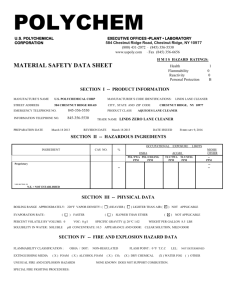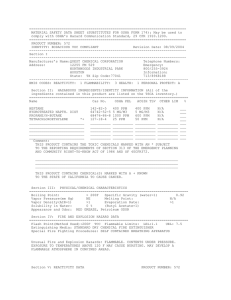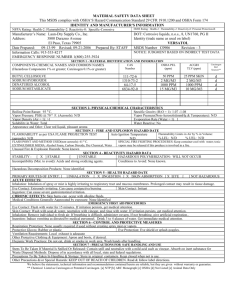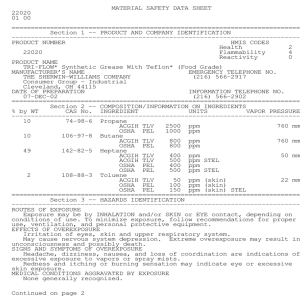Regular Unleaded Gasoline
advertisement
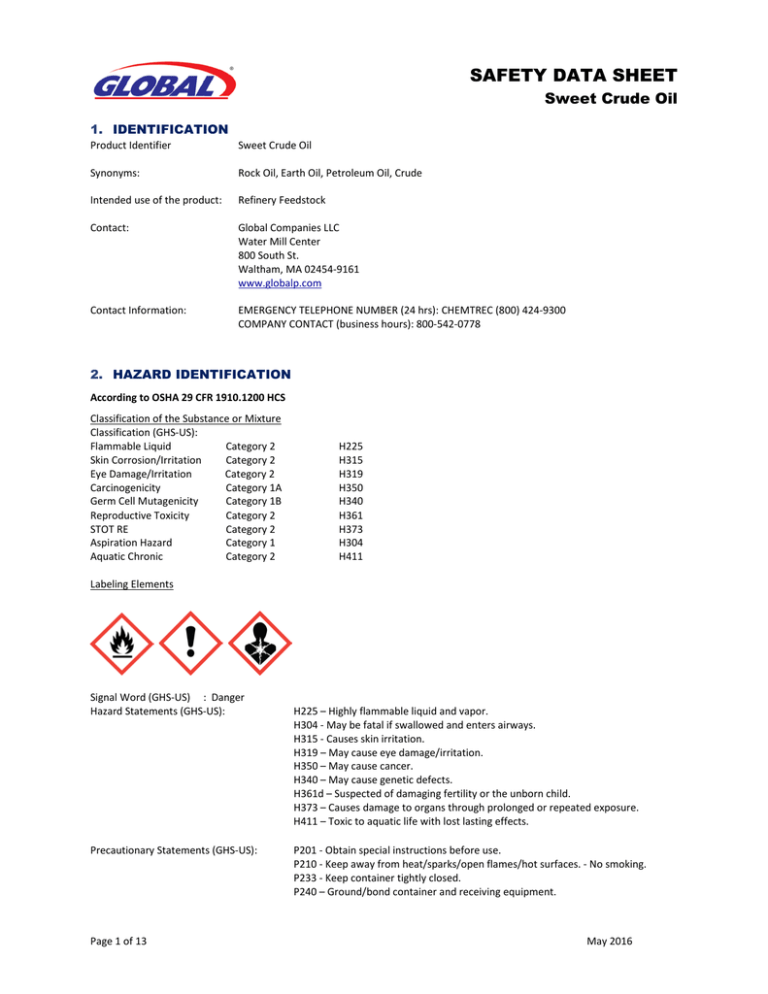
SAFETY DATA SHEET Sweet Crude Oil 1. IDENTIFICATION Product Identifier Sweet Crude Oil Synonyms: Rock Oil, Earth Oil, Petroleum Oil, Crude Intended use of the product: Refinery Feedstock Contact: Global Companies LLC Water Mill Center 800 South St. Waltham, MA 02454-9161 www.globalp.com Contact Information: EMERGENCY TELEPHONE NUMBER (24 hrs): CHEMTREC (800) 424-9300 COMPANY CONTACT (business hours): 800-542-0778 2. HAZARD IDENTIFICATION According to OSHA 29 CFR 1910.1200 HCS Classification of the Substance or Mixture Classification (GHS-US): Flammable Liquid Category 2 Skin Corrosion/Irritation Category 2 Eye Damage/Irritation Category 2 Carcinogenicity Category 1A Germ Cell Mutagenicity Category 1B Reproductive Toxicity Category 2 STOT RE Category 2 Aspiration Hazard Category 1 Aquatic Chronic Category 2 H225 H315 H319 H350 H340 H361 H373 H304 H411 Labeling Elements Signal Word (GHS-US) : Danger Hazard Statements (GHS-US): Precautionary Statements (GHS-US): Page 1 of 13 H225 – Highly flammable liquid and vapor. H304 - May be fatal if swallowed and enters airways. H315 - Causes skin irritation. H319 – May cause eye damage/irritation. H350 – May cause cancer. H340 – May cause genetic defects. H361d – Suspected of damaging fertility or the unborn child. H373 – Causes damage to organs through prolonged or repeated exposure. H411 – Toxic to aquatic life with lost lasting effects. P201 - Obtain special instructions before use. P210 - Keep away from heat/sparks/open flames/hot surfaces. - No smoking. P233 - Keep container tightly closed. P240 – Ground/bond container and receiving equipment. May 2016 SAFETY DATA SHEET Sweet Crude Oil P241 – Use explosion-proof electrical/ventilating/lighting equipment pursuant to applicable electrical code. P242 – Use only non-sparking tools. P243 – Take precautionary measures against static discharge. P260 - Do not breathe dust/fume/gas/mist/vapors/spray. P273 – Avoid release to the environment. P280 - Wear protective gloves/protective clothing/eye protection/face protection. P303+361+353 - If on skin (or hair): Take off immediately all contaminated clothing. Rinse with water/shower. P308+311 - If exposed or concerned: Get medical advice/attention. P301+310 - If swallowed: Immediately call a poison center/doctor/… P331 - Do NOT induce vomiting. P370+P378 – In case of fire use firefighting foam or other appropriate media for Class B fires to extinguish. P403+235 - Store in a well-ventilated place. Keep cool. P405 - Store locked up. P501 – Dispose of contents/container in accordance with local/regional/national/international regulation. Other information: NFPA 704 Health: 2 Fire: 3 Reactivity: 0 3. COMPOSITION / INFORMATION ON INGREDIENTS Chemical Composition Information Name Crude oil (as Oil Mist, mineral) Product Identifier (CAS#) 8002-05-9 % (w/w) 100 8012-95-1 Toluene 108-88-3 <5 Xylene, mixed isomers <5 Ethylbenzene 108-38-3 95-47-6 106-42-3 100-41-4 1,2,4- Trimethylbenzene 95-63-6 <5 n-Hexane 110-54-3 <5 Page 2 of 13 <5 Classification Carc 1B, H350 Asp 1, H304, Aquatic Chronic 4, H412 Flam liq 2, H225; Repro 2, H361d; STOT RE 2, H373; Asp 1, H304; Skin Irrit 2, H315; STOT SE 3, H336 Flam Liq 3, H226; Acute Tox 4, H332; Acute Tox 4, H312; Skin Irrit 2, H315 Flam Liq 2, H225; Acute Tox 4, H332; STOT RE 2, H373; Asp 1, H304 Flam Liq 3, H226; Acute Tox 4, H332; Skin Irrit 2, H315; Eye Irrit 2, H319; STOT SE 3, H335; Aquatic Chronic 2, H411 Flam liq 2, H225; Repro 2, H361f; STOT RE 2, H373; Asp 1, H304; Skin Irrit 2, H315; STOT SE 3, H336; Aquatic Chronic 2, H411 May 2016 SAFETY DATA SHEET Sweet Crude Oil Benzene Name Product Identifier (CAS#) 71-43-2 <0.5 % (w/w) Hydrogen Sulfide 7783-06-4 Trace - <1% Classification Flam liq 2, H225; Carc 1A, H350; Muta 1B H340; STOT RE 1, H372; Asp 1, H304; Eye Irrit 2, H319; Skin Irrit 2, H315 Fatal if inhaled, H330; Skin Irrit. 2, Eye Irrit. 2, STOT SE 3. Additional Formulation Information A complex combination of hydrocarbons including sulfur and nitrogen compounds such as naphtenes, paraffins, and aromatics. The composition and properties may vary significantly according to the source. Under extreme upset conditions very low levels of hydrogen sulfide may evolve. 4. FIRST AID MEASURES Route Inhalation Measures Remove person to fresh air. If person is not breathing, ensure an open airway and provide artificial respiration. If necessary, provide additional oxygen once breathing is restored if trained to do so. Seek medical attention immediately. Ingestion Aspiration Hazard: DO NOT INDUCE VOMITING. Do not give liquids. Obtain immediate medical attention. If spontaneous vomiting occurs, lean victim forward to reduce the risk of aspiration. Small amounts of material which enter the mouth should be rinsed out until the taste is dissipated. Eye Contact In case of contact with eyes, immediately flush with clean, low-pressure water for at least 15 minutes. Hold eyelids open to ensure adequate flushing. Seek medical attention. In case of contact lenses, remove immediately. Skin Contact Remove contaminated clothing and shoes. Wash contaminated areas thoroughly with soap and water or waterless hand cleanser. Obtain medical attention if irritation or redness develops. Thermal burns require immediate medical attention depending on the severity and of the area of the body burned. Most Important Symptoms Contact may cause eye, skin and mucous membrane irritation. Avoid prolonged breathing of vapors or mists. Inhalation may cause irritation. Long-term exposure may cause dermatitis (itching, irritation, pain and swelling). Significant exposure could cause pulmonary edema (aspiration hazard). Immediate Medical Attention and Special Treatment If ingested, do NOT induce vomiting, as this may cause chemical pneumonia (fluid in the lungs). Administer oxygen if breathing is labored. Contaminated clothing, including shoes, may be a fire hazard and should be discarded. 5. FIRE-FIGHTING MEASURES Extinguishing Media Small Fires: Small fires in the incipient (beginning) stage may typically be extinguished using handheld portable fire extinguishers and other firefighting equipment. Any extinguisher suitable for Class B fires such as dry chemical, C02, water spray, firefighting foam, or Halon should be used after the incipient stage. Large Fires: Fog or firefighting foam should be used to extinguish larger fires. Water may be ineffective for fighting this type of fire, but may be used to cool fire-exposed containers. For massive fires the use of unmanned hose holders or monitor nozzles may be advantageous to further minimize personnel exposure. Major fires may require withdrawal, allowing the tank to burn. Large storage tank fires typically require specially trained personnel and equipment to extinguish the fire, often including the need for properly applied firefighting foam. Page 3 of 13 May 2016 SAFETY DATA SHEET Sweet Crude Oil Specific Hazards / Products of Combustion Vapors may be ignited rapidly when exposed to heat, spark, open flame or other source of ignition. Flowing product may be ignited by self-generated static electricity. When mixed with air and exposed to an ignition source, flammable vapors can burn in the open or explode in confined spaces. Being heavier than air, vapors may travel long distances to an ignition source and flash back. Runoff to sewer may cause fire or explosion hazard. Combustion may produce smoke, carbon monoxide and other products of incomplete combustion Special Precautions and Protective Equipment for Firefighters Firefighting activities that may result in potential exposure to high heat, smoke or toxic by-products of combustion should require NIOSH/MSHA- approved pressure-demand self-contained breathing apparatus with full face piece and full protective clothing. Isolate area around container involved in fire. Cool tanks, shells, and containers exposed to fire and excessive heat with water. For massive fires the use of unmanned hose holders or monitor nozzles may be advantageous to further minimize personnel exposure. Major fires may require withdrawal, allowing the tank to burn. Large storage tank fires typically require specially trained personnel and equipment to extinguish the fire, often including the need for properly applied firefighting foam. See Section 9 for fire properties of this chemical including flash point, autoignition temperature, and explosive limits Special Instructions for Crude Oil During certain times of the year and/or in certain geographical locations, fuel oil may contain additional additives. Firefighting foam suitable for polar solvents is recommended for fuel with greater than 10% oxygenate concentration. Refer to NFPA 11 ‘Low Expansion Foam -1994 Edition.” 6. ACCIDENTAL RELEASE MEASURES ACTIVATE FACILITY SPCC, SPILL CONTINGENCY or EMERGENCY PLAN. Depending on the size of the spill, downwind receptors may need to be notified. Personal Precautions Use appropriate personal protective equipment to prevent eye/skin contact and absorption. Use NIOSH approved respiratory protection, if warranted, to prevent exposures above permissible limits (see Section 8). Contaminated clothing should not be near sources of ignition. Emergency Measures Evacuate nonessential personnel and remove or secure all ignition sources (flame, spark, hot work, hot metal, etc.). Consider wind direction; stay upwind and uphill, if possible. Evaluate the direction of product travel, diking, sewers, etc. to confirm spill areas. Do not touch or walk-through spilled material. Due to high vapor density, flammable / toxic vapors may be present in low lying areas, dikes, pits, drains, or trenches. Ventilate the area. Use of non-sparking tools and intrinsically safe equipment is recommended. Potential for flammable atmosphere should be monitored using a combustible gas indicator positioned downwind of the spill area. See Sections 2 and 7 for further hazard warnings and handling instructions. Environmental Precautions Stop the spill to prevent environmental release if it can be done safely. Product is toxic to aquatic life. Take action to isolate environmental receptors including drains, storm sewers and natural water bodies. Keep on impervious surface if at all possible. Use water sparingly to prevent product from spreading. Foam and absorbents may be used to reduce / prevent airborne release. Spills may infiltrate subsurface soil and groundwater; professional assistance may be necessary to determine the extent of subsurface impact. Follow federal, state or local requirements for reporting environmental release where necessary (see Section 15 for further information) Containment and Clean-Up Methods Carefully contain and stop the source of the spill, if safe to do so. Protect bodies of water by diking absorbents, or absorbent Page 4 of 13 May 2016 SAFETY DATA SHEET Sweet Crude Oil boom, if possible. Do not flush down sewer or drainage systems, unless system is designed and permitted to handle such material. The use of fire fighting foam may be useful in certain situations to reduce vapors. The proper use of water spray may effectively disperse product vapors or the liquid itself, preventing contact with ignition sources or areas/equipment that require protection. Take up with dry earth, sand or other non-combustible, inert oil absorbing materials. Carefully shovel, scoop or sweep up into a waste container with clean, non-sparking tools for reclamation or disposal. Response and clean-up crews must be properly trained and must utilize proper protective equipment (see Section 8). 7. HANDLING AND STORAGE Handling Precautions Handle as a flammable liquid. Keep away from heat, sparks, and open flame. No smoking. Electrical equipment should be approved for classified area. Bond and ground containers during product transfer pursuant to NFPA 70 and API RP 2003 to reduce the possibility of static-initiated fire or explosion. Follow precautions to prevent static initiated fire. Use good personal hygiene practices. Use only with protective equipment specified in Section 8. Avoid repeated and/or prolonged skin exposure. Use only outdoors or in well ventilated areas. Wash hands before eating, drinking, smoking, or using toilet facilities. Do not use as a cleaning solvent on the skin. Do not use solvents or harsh abrasive skin cleaners for washing this product from exposed skin areas. Waterless hand cleaners are effective. Promptly remove contaminated clothing and launder before reuse. Use care when laundering to prevent the formation of flammable vapors which could ignite via washer or dryer. Consider the need to discard contaminated leather shoes and gloves. Emergency eye wash capability should be available in the near proximity to operations presenting a potential splash exposure. Vapors are heavier than air and can accumulate in low lying areas (e.g., tanks, pits, vaults, dikes, drains, etc.) Follow specific procedures for confined space entry in areas where product may be present pursuant to OSHA requirements in 29 CFR 1910.146. Atmospheric testing using a combustible gas indicator may be necessary in confined areas where product may be present. Special slow load procedures for “switch loading” must be followed to avoid the static ignition hazard that can exist when higher flash point material (such as fuel oil) is loaded into tanks previously containing low flash point products (such as this product) - see API Publication 2003, “Protection Against Ignitions Arising Out Of Static, Lightning and Stray Currents. Storage Keep away from flame, sparks, excessive temperatures and open flame. Use approved vented containers. Keep containers closed and clearly labeled. Label all secondary containers that this material is transferred into with the chemical name and associated hazard(s). Empty product containers or vessels may contain explosive vapors. Do not pressurize, cut, heat, weld or expose such containers to sources of ignition. Separate from incompatible materials (see Section 10) by distance or secondary containment. Store in a well-ventilated area. Protect containers from damage and vehicular traffic. Post “No Smoking” signs in product storage areas. This storage area should comply with NFPA 30 “Flammable and Combustible Liquid Code”. Avoid storage near incompatible materials. The cleaning of tanks previously containing this product should follow API Recommended Practice (RP) 2013 “Cleaning Mobile Tanks In Flammable and Combustible Liquid Service” and API RP 2015 “Cleaning Petroleum Storage Tanks”. Incompatibles Keep away from strong oxidizers. 8. EXPOSURE CONTROLS / PERSONAL PROTECTION Occupational Exposure Limits Component Crude oil (as Oil Mist, mineral) Page 5 of 13 CAS # 8002-05-9 8012-95-1 List OSHA PEL OSHA PEL ACGIH TLV Value 500 ppm 5 mg/m3 5 mg/m3 May 2016 SAFETY DATA SHEET Sweet Crude Oil Component CAS # Benzene 71-43-2 Toluene 108-88-3 Xylene, mixed isomers 108-38-3 Ethylbenzene 100-41-4 1,2,4- Trimethylbenzene 95-63-6 n-Hexane 110-54-3 List ACGIH TLV-TWA ACGIH STEL OSHA AL OSHA TWA OSHA STEL ACGIH TWA OSHA TWA OSHA Ceiling limit OSHA Ceiling limit Peak ACGIH TWA ACGIH STEL OSHA PEL ACGIH TWA ACGIH TWA ACGIH STEL OSHA PEL OSHA STEL ACGIH TWA OSHA TWA ACGIH TLV-TWA OSHA PEL Value 0.5 ppm* Skin; A1; BEI 2.5 ppm* Skin; A1; BEI 0.5 ppm 1 ppm 5 ppm 20 ppm 200 ppm 300 ppm 500 ppm (10 min) 100 ppm 150 ppm 100 ppm 20 ppm 100 ppm 125 ppm 100 ppm 125 ppm 25 ppm 25 ppm 50 ppm 500 ppm Engineering Controls Use adequate ventilation to keep vapor concentrations of this product below occupational exposure and flammability limits, particularly in confined spaces. Intrinsically safe equipment and non-sparking tools shall be used in circumstances where concentrations may exceed lower flammable limits. Grounding and bonding shall be used to prevent accumulation and discharge of static electricity. Emergency shower and eyewash should be provided in proximity to handling areas in the event of exposure to decontaminate. Personal Protective Equipment Exposure Eye / Face Equipment Safety glasses or goggles are recommended where there is a possibility of splashing or spraying. Skin Gloves constructed of nitrile or neoprene are recommended when handling this material. If contact with the body is expected, chemical protective clothing such as of E.l. DuPont Tychem ®, Barricade®, or equivalent recommended based on degree of exposure. Note: The resistance of specific material may vary from product to product as well as with degree of exposure. Consult manufacturer specifications for further information. Note: The resistance of specific material may vary from product to product as well as with degree of exposure. Consult manufacturer specifications for further information. Respiratory Personal protective equipment (PPE) should meet recommended national standards. Respirator selection, use and maintenance should be in accordance with the requirements of the OSHA Respiratory Protection Standard, 29 CFR 1910.134 and the OSHA Benzene Standard, 29 CFR 1910.1028. Thermal Product is stored at ambient temperature. No thermal protection is required except for emergency operations involving actual or potential for fire. Other Equipment Chemical resistant gloves/gauntlets, boots, and apron. Monitoring of the concentration of substances in the breathing zone of workers or in the general workplace may be required to confirm compliance with an occupational exposure limit and adequacy of exposure controls. For some substances biological monitoring may also be appropriate. Validated exposure measurement methods should be applied by a competent person and samples analyzed by an accredited laboratory. Examples of sources of recommended exposure measurement methods are given below or contact the supplier. Further national methods may be available. Page 6 of 13 May 2016 SAFETY DATA SHEET Sweet Crude Oil 9. PHYSICAL AND CHEMICAL PROPERTIES Property Appearance Amber to Black Viscous Liquid Odor Mild Hydrocarbon or “rotten egg” Odor Threshold Not available pH Not available Melting / Freeze Point Not available Boiling Point And Range 75 - 120°F (35 to 538 C) Flash Point < 31 °F * (-1 C) Evaporation Rate Slow, varies with conditions Flammability Flammable liquid Flammability Limits 0.7 – 5% Vapor Pressure 10.8 – 750 mmHg Vapor Density Value > 1.5 – 3.0 Specific Gravity 0.75 – 1.0 Solubility 0.01 – 0.05 in H2O @100°F Partition Coefficient Not available Autoignition Temperature 428 – 590 °F * Decomposition Temperature Evaporation or ignition likely before decomposition will occur Viscosity Not available *At Normal Atmospheric Temperature and Pressure 10. STABILITY AND REACTIVITY Reactivity Material is not self-reacting; flammable concentrations may be present in air. Stability This is a stable material under normal ambient conditions. Hazardous polymerization will not occur under normal conditions of storage and use. Reactions / Polymerization Stable. Hazardous polymerization will not occur. Conditions to Avoid Avoid high temperatures, open flames, sparks, welding, smoking and other ignition sources Incompatible Materials Keep away from strong acids and oxidizers. Hazardous Decomposition Products Carbon monoxide, carbon dioxide and non-combusted hydrocarbons (smoke). Page 7 of 13 May 2016 SAFETY DATA SHEET Sweet Crude Oil Under extreme upset conditions hydrogen sulfide may evolve. 11. TOXICOLOGICAL INFORMATION Acute Toxicity: Acute Toxicity (Inhalation LC50) Benzene (71-43-2) LC50 Inhalation Rat Toluene (108-88-3) LC50 Inhalation Mouse LC50 Inhalation Rat 1,2,4 Trimethylbenzene (95-63-6) LC50 Inhalation Mouse Xylene (108-38-3) LC50 Inhalation Rat Acute Toxicity (Oral LC50) Benzene (71-43-2) LC50 Oral Rat Toluene (108-88-3) LC50 Oral Rat 1,2,4 Trimethylbenzene (95-63-6) LC50 Oral Rat Xylene (108-38-3) LC50 Oral Rat Ethylbenzene (100-41-4) LC50 Oral Rat 10,000 ppm/7 hr 5320 ppm/8 hr 8000 ppm/4 hr >2000 ppm/48 hr 6350 ppm/4 hr 3306 mg/kg 5000 mg/kg 3280 mg/kg (female) 3550 mg/kg (male) >3500 mg/kg 3500 mg/kg Acute Toxicity (Dermal LC50) Toluene (108-88-3) LC50 Dermal Rabbit 1,2,4 Trimethylbenzene (95-63-6) LC50 Dermal Rabbit Xylene (108-38-3) LC50 Dermal Rabbit Ethylbenzene (100-41-4) LC50 Dermal Rabbit 12,124 mg/kg >3160 mg/kg >43 g/kg 17,800 mg/kg Skin Corrosion/Irritation: Causes skin irritation. Serious Eye Damage/Irritation: Not classified Respiratory or Skin Sensitization: Not classified Germ Cell Mutagenicity: May cause genetic defects. Carcinogenicity: OSHA: No, IARC: No, NTP: No. IARC has determined there is “limited evidence for the carcinogenicity in experimental animals of crude oil” and “inadequate evidence for the carcinogenicity in humans of crude oil.” IARC concluded that “crude oil is not classifiable as to its carcinogenicity to humans (Group 3).” Individuals with preexisting disease of the skin may be at increased risk from exposure to this chemical. Exposure to sunlight may increase the degree of skin irritation. Page 8 of 13 May 2016 SAFETY DATA SHEET Sweet Crude Oil This product contains benzene. Human health studies indicate that prolonged and/or repeated overexposure to benzene may cause damage to the blood-forming system (particularly bone marrow), and serious blood disorders such as aplastic anemia and leukemia. The NTP, IARC, OSHA and ACGIH list benzene as a human carcinogen. Reproductive Toxicity: Suspected of damaging the unborn child. Teratogenicity: Not available Specific Target Organ Toxicity (Single Exposure): Single over-exposure likely to cause central nervous system effects (dizziness and drowsiness). May cause cardiac sensitization, narcosis and asphyxia. Specific Target Organ Toxicity (Repeated Exposure): May cause damage to organ systems through prolonged or repeated exposure. Lungs. Liver. Aspiration Hazard: This chemical is considered to be an aspiration hazard. Aspiration may result in chemical pneumonia (fluid in the lungs), severe lung damage, respiratory failure and even death. Potential Health Effects: Vapor irritating to eyes, nose, and throat. Ingestion may cause gastrointestinal disturbances, including irritation, nausea, vomiting and diarrhea, and central nervous system (brain) effects similar to alcohol intoxication. In severe cases, tremors, convulsions, loss of consciousness, coma, respiratory arrest, and death may occur. WARNING: the burning of any hydrocarbon as a fuel in an area without adequate ventilation may result in hazardous levels of combustion products, including carbon monoxide, and inadequate oxygen levels, which may cause unconsciousness, suffocation, and death. 12. ECOLOGICAL INFORMATION Toxicity: Material is toxic to aquatic organisms on an acute basis (LC50/EC50 between 1 and 10 mg/L in the most sensitive species tested). EC50 Daphnia LC 50 Fish 30 mmol/m3 (Exposure time: 48 h - Species: Daphnia magna) 7.7 mg/l (Exposure time: 96 h - Species: Pimephales promelas) This material is expected to be toxic to aquatic organisms and may cause long-term adverse effects in the aquatic environment. The product has not been tested. The statement has been derived from the properties of the individual components. Material is toxic to aquatic organisms based on an acute basis (LC50/EC50 >1 but < 10 mg/L in the most sensitive species tested). Material is a long-term aquatic hazard based on a chronic basis (NOEC or EC <1 mg/L in the most sensitive species tested). Persistence and Degradation: This material is not expected to be readily biodegradable. Bioaccumulative Potential: Not available Mobility in Soil: Not available Other Adverse Effects: None known Other Information: Avoid release to the environment. 13. DISPOSAL CONSIDERATIONS Consult federal, state and local waste regulations to determine appropriate disposal options. May be considered a hazardous waste if disposed. Direct solid waste (landfill) or incineration at a solid waste facility is not permissible. Do not discharge to sanitary or storm sewer. Personnel handling waste containers should follow precautions provided in this document. Page 9 of 13 May 2016 SAFETY DATA SHEET Sweet Crude Oil Shipping containers must be DOT authorized packages. Follow licensure and regulations for transport of hazardous material and hazardous waste as applicable. 14. TRANSPORT INFORMATION US DOT UN Identification Number Proper Shipping Name Hazard Class and Packing Group Shipping Label Placard / Bulk Package Emergency Response Guidebook Guide Number IATA UN Identification Number Shipping Name / Description Hazard Class and Packing Group ICAO Label Packing Instructions Cargo Max Quantity Per Package Cargo IMDG UN Identification Number Shipping Name / Description Hazard Class and Packing Group IMDG Label EmS Number Marine Pollutant UN 1267 Petroleum Crude Oil 3, PG I Flammable Liquid 128 UN1267 Petroleum Crude Oil 3, PG I 3 I UN1267 Petroleum Crude Oil 3, PG I 3 F-E S-E Yes 15. REGULATORY INFORMATION U.S. Federal, State, and Local Regulatory Information Any spill or uncontrolled release of this product, including any substantial threat of release, may be subject to federal, state and/or local reporting requirements. This product and/or its constituents may also be subject to other federal, state, or local regulations; consult those regulations applicable to your facility/operation. OSHA Hazard Communication Standard This product is a "Hazardous Chemical" as defined by the OSHA Hazard Communication Standard, 29 CFR 1910.1200. Superfund Amendments and Reauthorization Act of 1986 Title III (Emergency Planning and Community Right-to-Know Act of 1986) Sections 311 and 312 Immediate (Acute) Health Hazard: Yes Delayed (Chronic) Health Hazard: Yes Fire Hazard: Yes Reactive Hazard: No Sudden Release of Pressure Hazard: No Clean Water Act (Oil Spills) Any spill or release of this product to “navigable waters” (essentially any surface water, including certain wetlands) or adjoining shorelines sufficient to cause a visible sheen or deposit of a sludge or emulsion must be reported immediately to the National Response Center (1-800-424-8802) or, if not practical, the U.S. Coast Guard with follow-up to the National Response Center, as required by U.S. Federal Law. Also contact appropriate state and local regulatory agencies as required. CERCLA Section 103 and SARA Section 304 (Release to the Environment) The CERCLA definition of hazardous substances contains a “petroleum exclusion” clause which exempts crude oil, refined, and unrefined petroleum products and any indigenous components of such. However, other federal reporting requirements (e.g., SARA Section 304 as well as the Clean Water Act if the spill occurs on navigable waters) may still apply. Page 10 of 13 May 2016 SAFETY DATA SHEET Sweet Crude Oil CERCLA (Superfund) reportable quantity (lbs) (40 CFR 302.4): • Naphthalene: 100 SARA Section 313- Supplier Notification This product contains the following toxic chemicals subject to the reporting requirements of section 313 of the Emergency Planning and Community Right-To-Know Act (EPCRA) of 1986 and of 40 CFR 372. • Benzene (71-43-2) • Ethyl Benzene (100-41-4) • n-Hexane (110-54-3) • Toluene (108-88-3) • 1,2,4- Trimethylbenzene (95-63-6) • Xylene, mixed isomers (108-88-3) Information on each ingredient’s concentration can be found in Section 3 Information on each ingredient’s exposure limits can be found in Section 8 EPA Notification (Oil Spills) If the there is a discharge of more than 1,000-gallons of oil into or upon navigable waters of the United States, or if it is the second spill event of 42 gallons or more of oil into water within a twelve (12) month period, a written report must be submitted to the Regional Administrator of the EPA within sixty days of the event. Pennsylvania Right to Know Hazardous Substance list: The following product components are cited in the Pennsylvania Special Hazardous Substance List, and are present at levels which require reporting. Component Petroleum distillates Benzene Xylene, mixed isomers Toluene 1,2,4-Trimethylbenzene Ethylbenzene n-Hexane CAS 8002-05-9 71-43-2 108-38-3 108-88-3 95-63-6 100-41-4 110-54-3 Amount 100% <0.5% <5% <5% <5% <5% <5% New Jersey Right to Know Hazardous Substance list: The following product components are cited in the New Jersey Right to Know Hazardous Substance List, and are present at levels which require reporting. Component Petroleum distillates Benzene Xylene Toluene 1,2,4-Trimethylbenzene Ethylbenzene n-Hexane CAS 8002-05-9 71-43-2 108-38-3 108-88-3 95-63-6 100-41-4 110-54-3 Amount 100% <0.5% <5% <5% <5% <5% <5% California Prop. 65 WARNING: This product contains chemicals known to the State of California to cause Cancer or Reproductive Toxicity. Component Benzene Toluene Ethylbenzene CAS 71-43-2 108-88-3 100-41-4 Amount 0.1-4.9% 0-15% <4% U.S. Toxic Substances Control Act All components of this product are on the TSCA Inventory or are exempt from TSCA Inventory requirements under 40 CFR 720.30. Page 11 of 13 May 2016 SAFETY DATA SHEET Sweet Crude Oil CEPA - Domestic Substances List (DSL) All substances contained in this product are listed on the Canadian Domestic Substances List (DSL) or are not required to be listed. Canadian Regulatory Information (WHMIS) Class B, Division 2 (Flammable Liquid) Class D, Division 2B (Toxic by other means) 16. OTHER INFORMATION Version Issue Date Prior Issue Date 4 May 20, 2016 March 3, 2015 Description of Revisions Revised to meet Globally Harmonized System for chemical hazard communication requirements pursuant to OSHA regulatory revisions 77 FR 17884, March 26, 2012. Abbreviations ˚F Degrees fahrenheit (temperature) < Less than = Equal to > Greater than AP Approximately C Centigrade (temperature) kg Kilogram L Liter mg Milligrams Acronyms ACGIH American Conference of Governmental Industrial Hygienists AIHA American Industrial Hygiene Association AL Action Level ANSI American National Standards Institute API American Petroleum Institute CAS Chemical Abstract Service CERCLA Comprehensive Emergency Response, Compensation, and Liability Act DOT U.S. Department of Transportation EC50 Ecological concentration 50% EPA U.S. Environmental Protection Agency ERPG Emergency Response Planning Guideline GHS Global Harmonized System HMIS Hazardous Materials Information System IARC International Agency for Research On Cancer IATA International Air Transport Association IMDG International Maritime Dangerous Goods Koc Soil Organic Carbon LC50 Lethal concentration 50% LD50 Lethal dose 50% MSHA Mine Safety and Health Administration NFPA National Fire Protection Association NIOSH National Institute of Occupational Safety and Health NOIC Notice of Intended Change Page 12 of 13 mL mm2 mmHg N/A N/D ppm sec ug NTP OPA OSHA PEL RCRA REL RVP SARA SCBA SPCC STEL TLV TSCA TWA UN UNECE WEEL WHMIS Milliliter Square millimeters Millimeters of mercury (pressure) Not applicable Not determined Parts per million Second Micrograms National Toxicology Program Oil Pollution Act of 1990 U.S. Occupational Safety & Health Administration Permissible Exposure Limit (OSHA) Resource Conservation and Recovery Act Reauthorization Act of 1986 Title III Recommended Exposure Limit (NIOSH) Reid Vapor Pressure Superfund Amendments and Self Contained Breathing Apparatus Spill Prevention, Control, and Countermeasures Short-Term Exposure Limit (generally 15 minutes) Threshold Limit Value (ACGIH) Toxic Substances Control Act Time Weighted Average (8 hr.) United Nations United Nations Economic Commission for Europe Workplace Environmental Exposure Level (AIHA) Canadian Workplace Hazardous Materials Information System May 2016 SAFETY DATA SHEET Sweet Crude Oil Disclaimer of Expressed and Implied Warranties Information presented herein has been compiled from sources considered to be dependable, and is accurate and reliable to the best of our knowledge and belief, but is not guaranteed to be so. Since conditions of use are beyond our control, we make no warranties, expressed or implied, except those that may be contained in our written contract of sale or acknowledgment. Vendor assumes no responsibility for injury to vendee or third persons proximately caused by the material if reasonable safety procedures are not adhered to as stipulated in the data sheet. Additionally, vendor assumes no responsibility for injury to vendee or third persons proximately caused by abnormal use of the material, even if reasonable safety procedures are followed. Furthermore, vendee assumes the risk in their use of the material. ** End of Safety Data Sheet ** Page 13 of 13 May 2016
